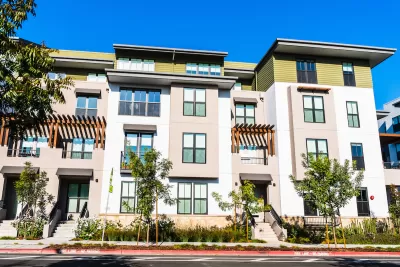The way apartment buildings are financed has a major impact on supply and costs.

In a piece for Strong Towns, Charles Marohn seeks clarity on the many rumors swirling about the U.S. housing market. “If we listen to those concerned about housing affordability, rents are already too high and may only go higher. If we listen to those concerned about housing finance, panic sits just under the surface because rents are about to collapse. Can both of these narratives be true?”
Marohn explains how the way that multifamily residential buildings are financed has a lot to do with rent costs and supply. “The way you make money in commercial real estate today is by leveraging lots of debt. This is one of the reasons that just 25 developers were responsible for one in four multifamily units started in 2022, an astounding level of concentration in a market with over 60,000 developers.”
Marohn notes that the current system of commercial debt worked for property owners and lenders for decades. Now, things are coming to a head. “There are many reasons why there is such hyperventilating over higher interest rates (I mean, we are ridiculously overindebted at all levels of society), but one enormous reason is that it forces the issue on commercial real estate. When the loan is rolled over, the numbers don’t work anymore.”
According to Marohn, it’s possible that lower interest rates made it easier for investors to withhold real, vacant apartment from the market to restrict supply and drive up rents. “If you think building more units in this same top-down, financialized system is going to fix things, you’re stuck in the housing trap. There’s only one way out: a bottom-up revolution in how we deliver lots of units at prices anchored to local capacity.”
FULL STORY: Are Rents About to Crash?

Alabama: Trump Terminates Settlements for Black Communities Harmed By Raw Sewage
Trump deemed the landmark civil rights agreement “illegal DEI and environmental justice policy.”

Study: Maui’s Plan to Convert Vacation Rentals to Long-Term Housing Could Cause Nearly $1 Billion Economic Loss
The plan would reduce visitor accommodation by 25% resulting in 1,900 jobs lost.

Planetizen Federal Action Tracker
A weekly monitor of how Trump’s orders and actions are impacting planners and planning in America.

Wind Energy on the Rise Despite Federal Policy Reversal
The Trump administration is revoking federal support for renewable energy, but demand for new projects continues unabated.

Passengers Flock to Caltrain After Electrification
The new electric trains are running faster and more reliably, leading to strong ridership growth on the Bay Area rail system.

Texas Churches Rally Behind ‘Yes in God’s Back Yard’ Legislation
Religious leaders want the state to reduce zoning regulations to streamline leasing church-owned land to housing developers.
Urban Design for Planners 1: Software Tools
This six-course series explores essential urban design concepts using open source software and equips planners with the tools they need to participate fully in the urban design process.
Planning for Universal Design
Learn the tools for implementing Universal Design in planning regulations.
Caltrans
Smith Gee Studio
Institute for Housing and Urban Development Studies (IHS)
City of Grandview
Harvard GSD Executive Education
Toledo-Lucas County Plan Commissions
Salt Lake City
NYU Wagner Graduate School of Public Service





























